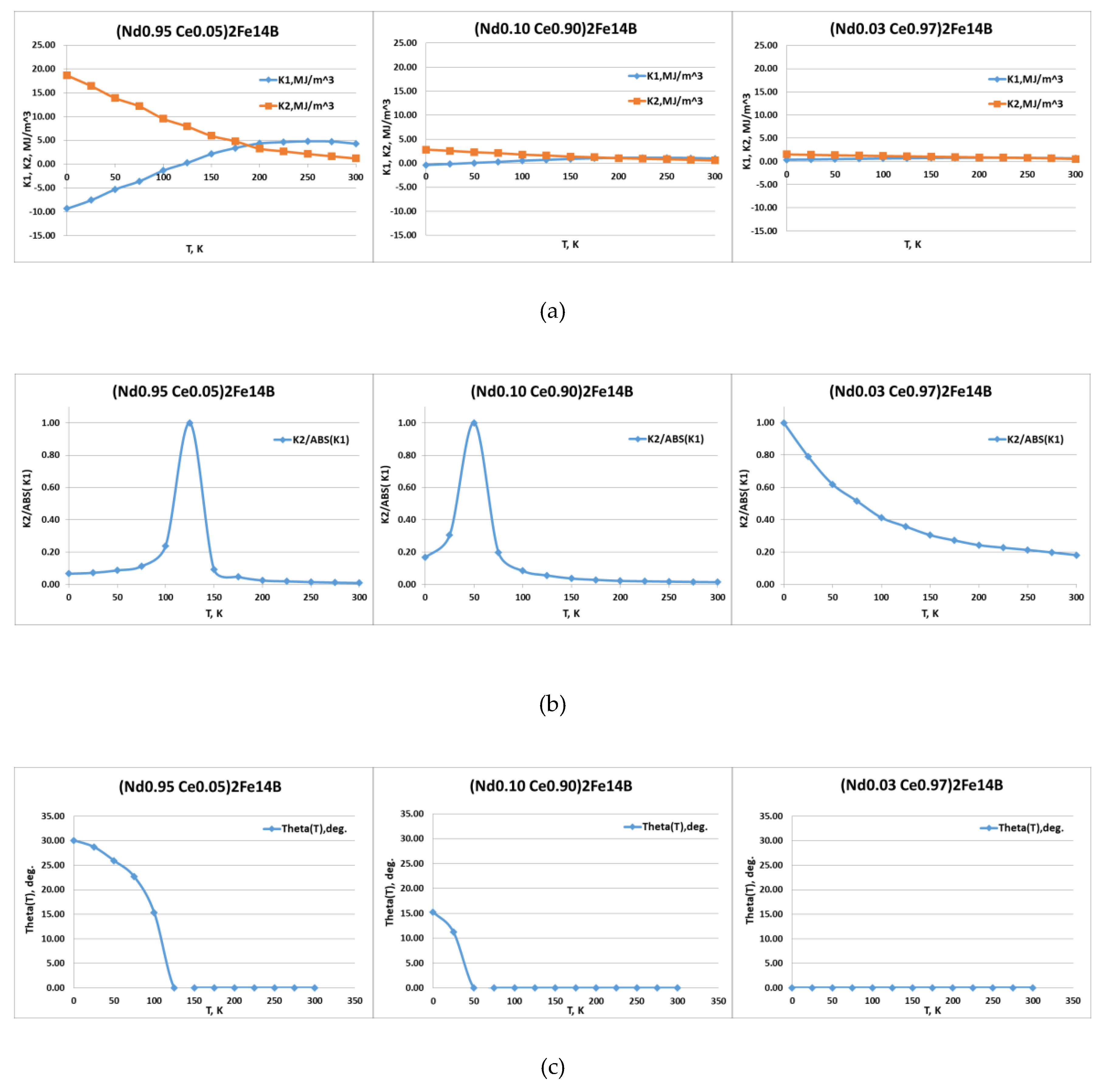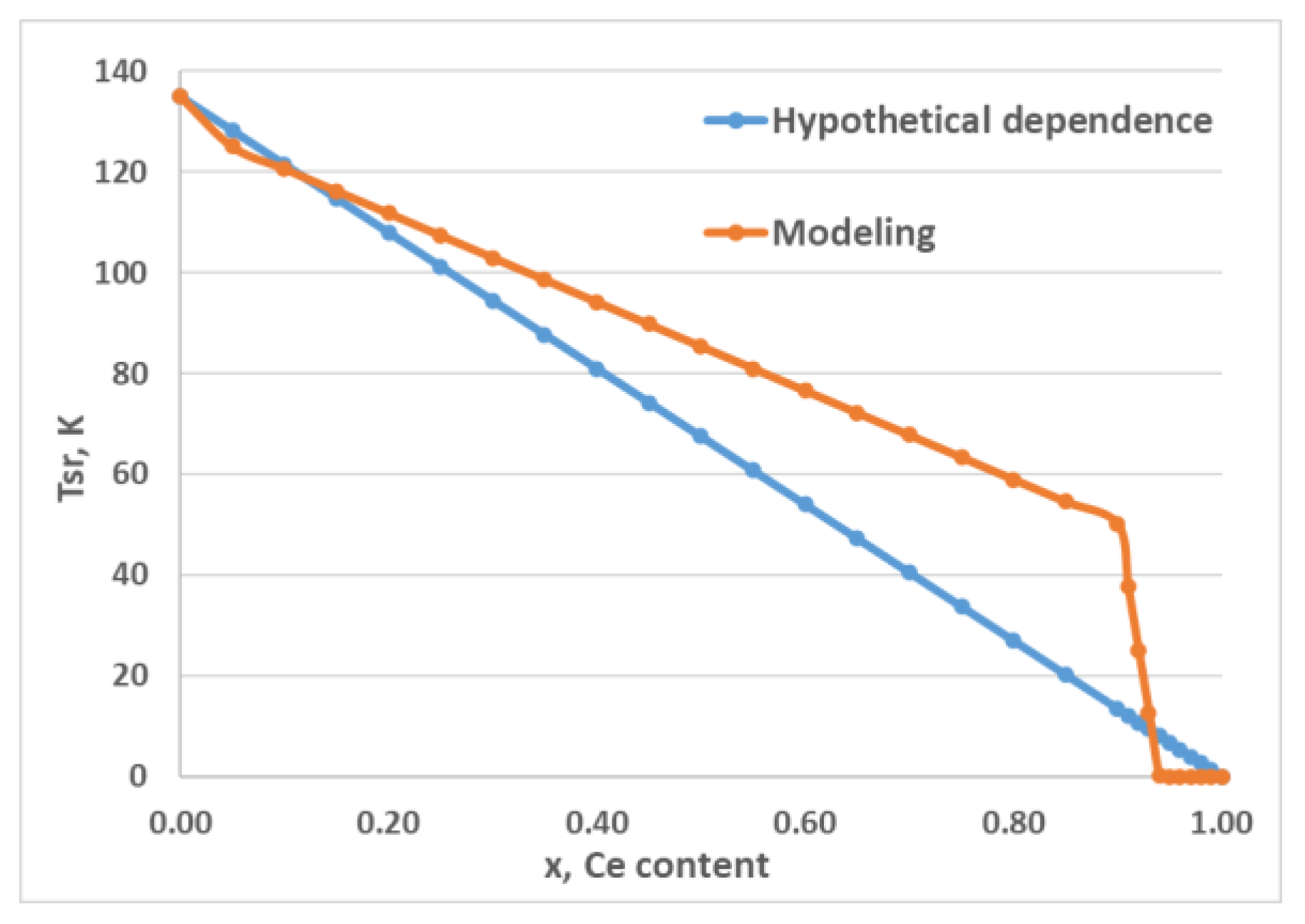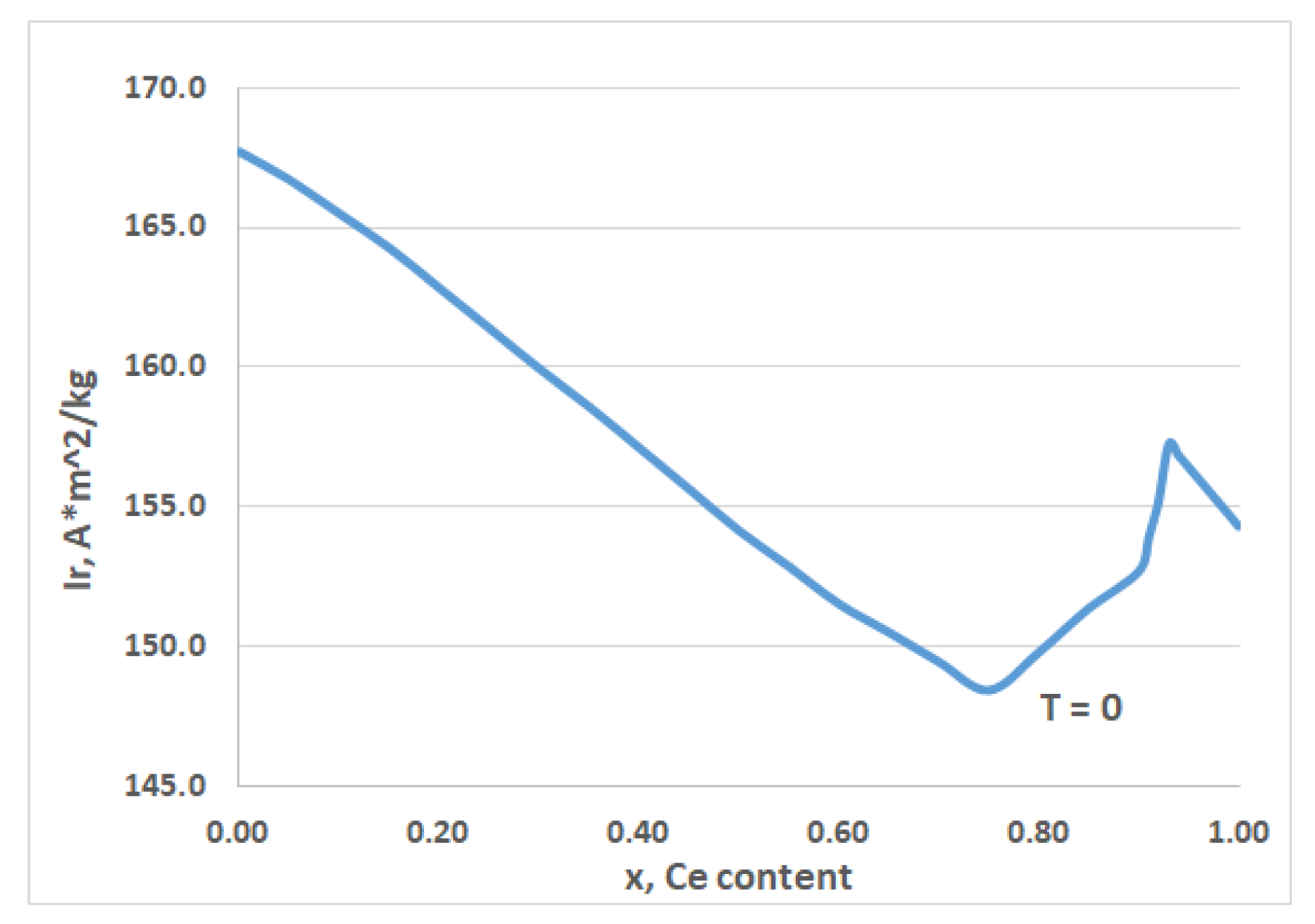Simulating the Hysteretic Characteristics of Hard Magnetic Materials Based on Nd2Fe14B and Ce2Fe14B Intermetallics
Abstract
1. Introduction
2. Algorithm and Model for Calculating the Hysteresis Loops of Hard Magnetic Materials with the Uniaxial Tetragonal Lattice
3. Results and Discussion
3.1. Determination of Magnetic Anisotropy Constants, Normalized Ratio of Anisotropy Constants (K2/|K1|), and Angle of the EMA cone in Calculating Hysteresis Loops of the (Nd1−x Cex)2Fe14B Intermetallics with 0 ≤ x ≤1
3.2. Simulation of Magnetization Curves and Hysteresis Loops of (Nd1−x Cex)2Fe14B with x = 0.00–1.00
4. Conclusions
Author Contributions
Funding
Acknowledgments
Conflicts of Interest
References
- Li, Z.; Liu, W.; Zha, S.; Li, Y.; Wang, Y.; Zhang, D.; Yue, M.; Zhang, J.; Huang, X. Effects of Ce substitution on the microstructures and intrinsic magnetic properties of Nd–Fe–B alloy. J. Mag. Mag. Mater. 2015, 393, 551–554. [Google Scholar] [CrossRef]
- Zhao, L.; Li, C.; Hao, Z.; Liu, X.; Liao, X.; Zhang, J.; Su, K.; Li, L.; Yu, H.; Greneche, J.-M.; et al. Influences of element segregation on the magnetic properties in nanocrystalline Nd-Ce-Fe-B alloys. Mater. Charact. 2019, 148, 208–213. [Google Scholar] [CrossRef]
- Raghavan, V. The B-Ce-Fe (Boron-Cerium-Iron) System. In Phase Diagrams of Ternary Iron Alloys; Indian Institute of Metals: Kolkata, India, 1992; Volume 6A, pp. 297–300. [Google Scholar]
- Herbst, J.F. R2Fe14B materials: Intrinsic properties and technological aspects. Rev. Mod. Phys. 1991, 63, 819–898. [Google Scholar] [CrossRef]
- Hirosawa, S.; Matsuura, Y.; Yamamoto, H.; Fujimura, S.; Sagawa, M.; Sagawa, M.; Yamauchi, H. Magnetization and magnetic anisotropy of R2Fe14B measured on single crystals. J. Appl. Phys. 1986, 59, 873–879. [Google Scholar] [CrossRef]
- Fruchart, R.; L’Heritier, P.; Dalmas de Reotier, P.; Fruchart, D.; Wolfers, P.; Coey, J.M.D.; Ferreira, L.P.; Guillen, R.; Vulliet, P.; Yaouanc, A. Mossbauer spectroscopy of R2Fe14B. J. Phys. F Met. Phys. 1987, 17, 483–502. [Google Scholar] [CrossRef]
- Grössinger, R.; Sun, X.K.; Eibler, R.; Buschow, K.H.J.; Kirchmayr, H.R. Temperature dependences of anisotropy fields and initial susceptibilities in R2Fe14B compounds. J. Magn. Magn. Mater. 1986, 58, 55–60. [Google Scholar] [CrossRef]
- Haskel, D.; Lang, J.C.; Islam, Z.; Cady, A.; Srajer, G.; van Veenendaal, M.; Canfield, P.C. Atomic Origin of Magnetocrystalline Anisotropy in Nd2Fe14B. Phys. Rev. Lett. 2005, 95, 217207. [Google Scholar] [CrossRef]
- Colin, C.V.; Ito, M.; Yano, M.; Dempsey, N.M.; Suard, E.; Givord, D. Solid-solution stability and preferential site occupancy in (R-R′)2Fe14B compounds. Appl. Phys. Lett. 2016, 108, 242415. [Google Scholar] [CrossRef]
- Bolzoni, F.; Gavigan, J.P.; Givord, D.; Li, H.S.; Moze, O.; Pareti, L. 3d magnetism in R2Fe14B compounds. J. Magn. Magn. Mater. 1987, 66, 158. [Google Scholar] [CrossRef]
- Alam, A.; Khan, M.; McCallum, R.W.; Johnson, D.D. Site-preference and valency for rare-earth sites in (R-Ce)2Fe14B magnets. Appl. Phys. Lett. 2013, 102, 042402. [Google Scholar] [CrossRef]
- Abache, C.; Oesterreicher, J. Magnetic anisotropies and spin reorientations of R2Fe14B-type compounds. J. Appl. Phys. 1986, 60, 3671. [Google Scholar] [CrossRef]
- Hallemans, B.; Wollants, P.; Roos, J.R. Thermodynamic assessment of the Fe-Nd-B phase diagram. J. Phase Equilib. 1995, 16, 137–149. [Google Scholar] [CrossRef]
- Li, Z.B.; Shen, B.G.; Zhang, M.; Hu, F.X.; Sun, J.R. Substitution of Ce for Nd in preparing R2Fe14B nanocrystalline magnets. J. Alloy Compd. 2015, 628, 325–328. [Google Scholar] [CrossRef]
- Wang, J.; Liang, L.; Zhang, L.T.; Yano, M.; Terashima, K.; Kada, H.; Kato, S.; Kadono, T.; Imada, S.; Nakamura, T.; et al. Mixed-valence state of Ce and its individual atomic moments in Ce2Fe14B studied by soft X-ray magnetic circular dichroism. Intermetallics 2016, 69, 42–46. [Google Scholar] [CrossRef]
- Fan, X.; Ding, G.; Chen, K.; Guo, S.; You, C.; Chen, R.; Lee, D.; Yan, A. Whole process metallurgical behavior of the high-abundance rare-earth elements LRE (La, Ce and Y) and the magnetic performance of Nd0.75LRE0.25-Fe-B sintered magnets. Acta Mater. 2018, 154, 343–354. [Google Scholar] [CrossRef]
- Jiang, Q.; Zhong, Z. Research and development of Ce-containing Nd2Fe14B-type alloys and permanent magnetic materials. J. Mater. Sci. Technol. 2017, 33, 1087–1096. [Google Scholar] [CrossRef]
- Pei, K.; Zhang, X.; Lin, M.; Yan, A.R. Effects of Ce-substitution on magnetic properties and microstructure of Nd–Pr–Fe–B melt-spun powders. J. Magn. Magn. Mater. 2016, 398, 96–100. [Google Scholar] [CrossRef]
- Yan, C.; Guo, S.; Chen, R.; Lee, D.; Yan, A. Effect of Ce on the Magnetic Properties and Microstructure of Sintered Didymium-Fe-B Magnets. IEEE Trans. Magn. 2014, 50, 2102605. [Google Scholar] [CrossRef]
- Pathak, A.K.; Gschneidner, K.A.; Khan, M.; McCallum, R.W.; Pecharsky, V.K. High performance Nd-Fe-B permanent magnets without critical elements. J. Alloys Compd. 2016, 668, 80–86. [Google Scholar] [CrossRef]
- Fuerst, C.D.; Herbst, J.F.; Sarrao, J.L.; Migliori, A. Resonant ultrasound measurements of elastic constants of melt-spun of R2Fe14B compounds (R=Ce, Pr, Nd, Er). J. Appl. Phys. 1994, 75, 6625–6627. [Google Scholar] [CrossRef]
- Susner, M.A.; Conner, B.S.; Saparov, B.I.; McGuire, M.A.; Crumlin, E.J.; Veith, G.M.; Cao, H.; Shanavas, K.V.; Parker, D.S.; Chakoumakos, B.C.; et al. Flux growth and characterization of Ce-substituted Nd2Fe14B single crystals. J. Mag. Mag. Mater. 2017, 434, 1–9. [Google Scholar] [CrossRef]
- Menushenkov, V.; Savchenko, A.; Stoliarov, V.; Zheleznyi, M.; Kolchugina, N.; Dormidontov, N.; Skotnicova, K.; Koshkidko, Y. Simulation of demagnetization reversal and hysteretic loops of (Nd, Pr)2Fe14B magnets at low temperatures. In Proceedings of 28-th International Conference on Metallurgy and Materials, Metal 2019, Brno, Czech Republic, 22–24 May 2019; Tanger Ltd.: Ostrava, Czech Republic, 2019; pp. 1621–1627. [Google Scholar]
- Jiang, S.; Li, H.; Xu, J.; Gao, R. Research on the origin of magneto-crystalline anisotropy in R2Fe14B compounds. J. Mag. Mag. Mater. 1994, 136, 294–300. [Google Scholar]
- Xu, W.G.; Liu, Y.L.; Ji, S.Q.; Chu, D.P.; Xu, Y.; Yang, G.L. Temperature dependence of the anisotropy constants K1 and K2 of R2Fe14B (R. = Ce, Pr, Gd). Acta Sin. 1986, 35, 1592–1597. [Google Scholar]





| Compound | Is, T | HA, kOe | TC, К | а, nm | с, nm | Reference |
| Nd2Fe14B | 1.61 | 73 | 585 | 0.880 | 1.220 | [4,5] |
| Pr2Fe14B | 1.56 | 87 | 565 | 0.880 | 1.223 | [4,6] |
| Ce2Fe14B | 1.17 | 26 | 424 | 0.876 | 1.211 | [4,7] |
© 2020 by the authors. Licensee MDPI, Basel, Switzerland. This article is an open access article distributed under the terms and conditions of the Creative Commons Attribution (CC BY) license (http://creativecommons.org/licenses/by/4.0/).
Share and Cite
Kolchugina, N.B.; Zheleznyi, M.V.; Savchenko, A.G.; Menushenkov, V.P.; Burkhanov, G.S.; Koshkid’ko, Y.S.; Ćwik, J.; Dormidontov, N.A.; Skotnicova, K.; Kursa, M.; et al. Simulating the Hysteretic Characteristics of Hard Magnetic Materials Based on Nd2Fe14B and Ce2Fe14B Intermetallics. Crystals 2020, 10, 518. https://doi.org/10.3390/cryst10060518
Kolchugina NB, Zheleznyi MV, Savchenko AG, Menushenkov VP, Burkhanov GS, Koshkid’ko YS, Ćwik J, Dormidontov NA, Skotnicova K, Kursa M, et al. Simulating the Hysteretic Characteristics of Hard Magnetic Materials Based on Nd2Fe14B and Ce2Fe14B Intermetallics. Crystals. 2020; 10(6):518. https://doi.org/10.3390/cryst10060518
Chicago/Turabian StyleKolchugina, Natalia B., Mark V. Zheleznyi, Aleksandr G. Savchenko, Vladimir P. Menushenkov, Gennadii S. Burkhanov, Yurii S. Koshkid’ko, Jacek Ćwik, Nikolai A. Dormidontov, Katerina Skotnicova, Miroslav Kursa, and et al. 2020. "Simulating the Hysteretic Characteristics of Hard Magnetic Materials Based on Nd2Fe14B and Ce2Fe14B Intermetallics" Crystals 10, no. 6: 518. https://doi.org/10.3390/cryst10060518
APA StyleKolchugina, N. B., Zheleznyi, M. V., Savchenko, A. G., Menushenkov, V. P., Burkhanov, G. S., Koshkid’ko, Y. S., Ćwik, J., Dormidontov, N. A., Skotnicova, K., Kursa, M., & Prokofev, P. A. (2020). Simulating the Hysteretic Characteristics of Hard Magnetic Materials Based on Nd2Fe14B and Ce2Fe14B Intermetallics. Crystals, 10(6), 518. https://doi.org/10.3390/cryst10060518







